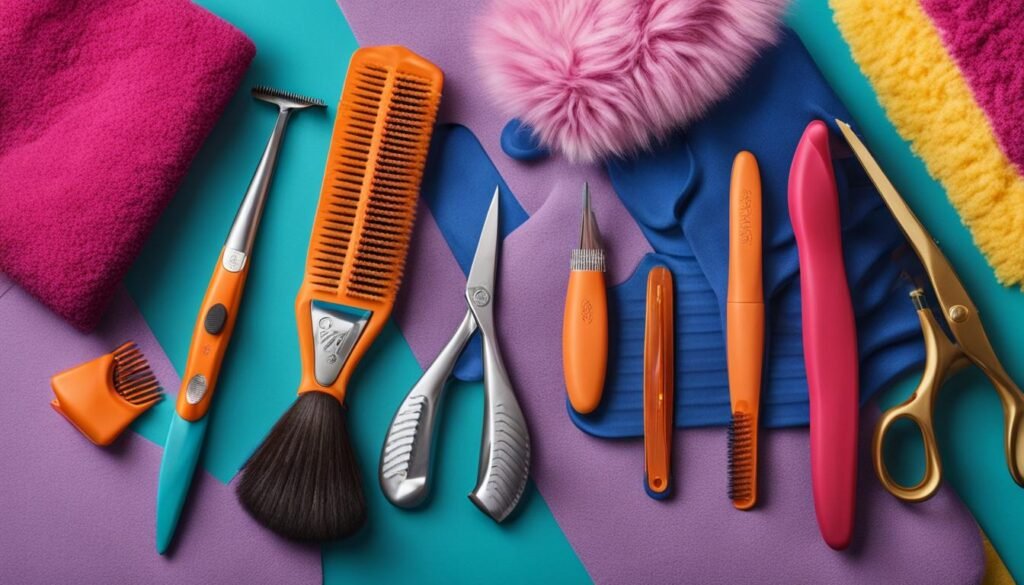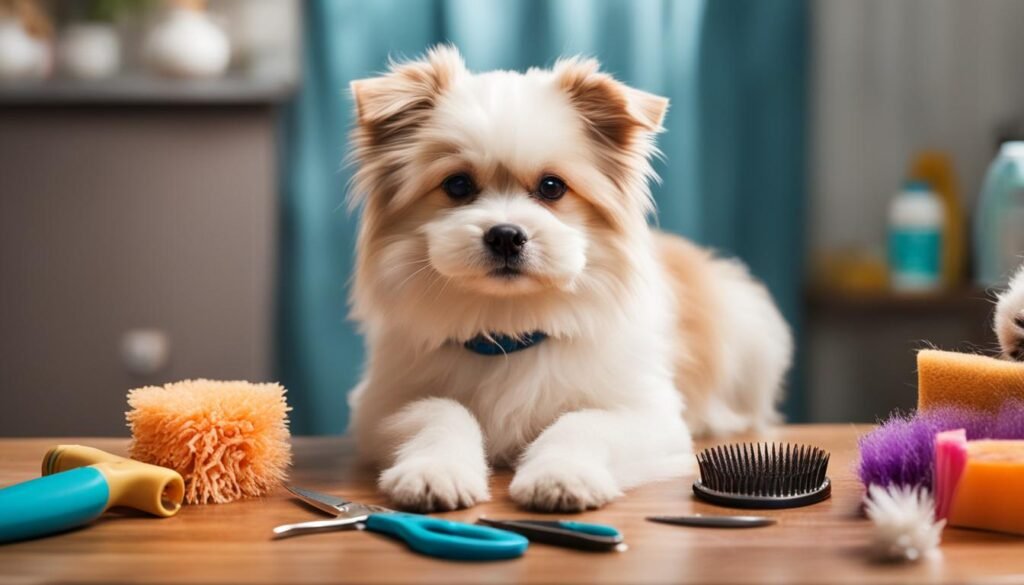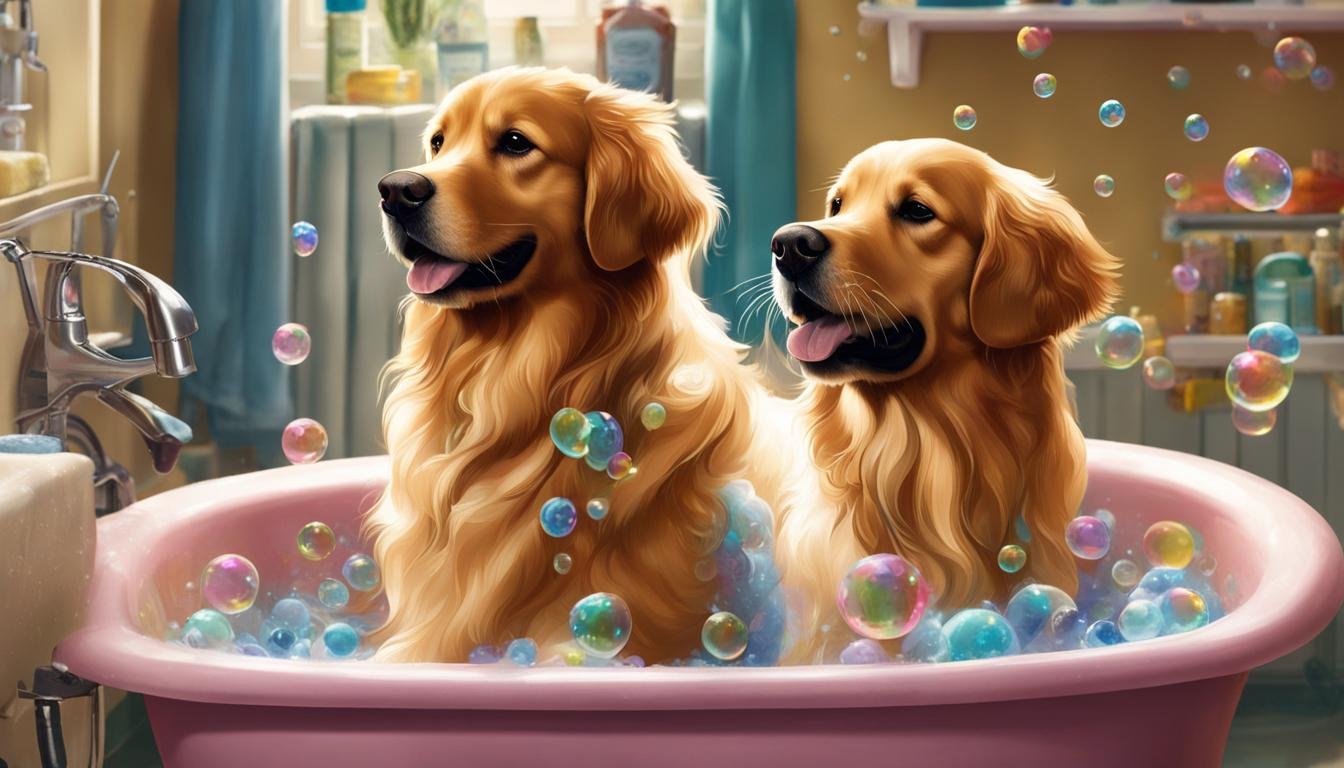Grooming your pet at home can be a fulfilling and cost-effective way to ensure they look and feel their best. In this comprehensive guide, we will explore expert DIY grooming techniques that you can easily perform in the comfort of your own home. From creating a stress-free grooming environment to selecting the right tools and mastering brushing techniques, we will cover everything you need to know to give your pet professional-quality grooming at home.
Key Takeaways:
- DIY pet grooming allows you to save money while bonding with your pet.
- Creating a stress-free grooming environment is crucial for a positive grooming experience.
- Choosing the right grooming tools is essential for effective DIY pet grooming.
- Mastering brushing techniques for different coat types will keep your pet’s coat healthy and shiny.
- Following a step-by-step grooming guide will ensure a thorough and successful grooming session.
Establishing a Stress-Free Grooming Environment at Home
Grooming your beloved pet at home can be a rewarding experience, but it’s important to ensure a stress-free environment that promotes a positive grooming experience. By creating a dedicated grooming space and focusing on your pet’s comfort, you can make the grooming process enjoyable for both of you.
Creating a Positive Grooming Space
To establish a positive grooming space, find an area in your home where you can set up a grooming station. This could be a bathroom, laundry room, or any other enclosed space that allows you to contain the grooming process. Clear the area of any hazards or distractions that may cause anxiety or discomfort to your pet.
You can also create a calming atmosphere by using soft lighting, playing soothing music, or using essential oils with pet-friendly scents. These simple additions can help create a tranquil ambiance for your pet during grooming sessions.
Ensure that you have all the necessary grooming tools and supplies within reach. This will make the process more efficient and minimize any unnecessary movement that could cause stress to your pet. Keep brushes, combs, clippers, and other grooming accessories organized and easily accessible in your grooming space.
Ensuring Your Pet’s Comfort Before You Begin
Before starting the grooming session, take a few moments to ensure your pet’s comfort. Begin by giving them an opportunity to relieve themselves and stretch their legs. This will help them feel more relaxed and reduce the chances of interruptions during the grooming process.
Make sure the grooming area is at a comfortable temperature. If grooming in a bathroom, close any windows or doors to keep the room warm. If grooming in a colder environment, provide a warm towel or blanket for your pet to sit on during the grooming session.
It’s also important to introduce your pet to the grooming tools and equipment gradually. Offer treats and praise while allowing them to sniff and explore the tools. This positive reinforcement will help create a positive association with the grooming process.
Throughout the grooming session, monitor your pet’s body language and behavior. Take breaks if necessary and provide reassurance and plenty of pets and praise. Remember, the goal is to create a stress-free environment that makes your pet feel safe and comfortable during grooming.
Selecting the Right Tools for DIY Pet Grooming
Choosing the right tools is essential for successful DIY pet grooming. By selecting the appropriate grooming tools for your pet’s specific needs, you can ensure a comfortable and effective grooming experience.

When it comes to grooming tools, there is a wide range of options available in the market. Understanding the different types of brushes, combs, clippers, and other grooming accessories will help you make informed choices for your pet.
Brushes: There are various brushes available, designed to cater to different coat types. Bristle brushes work well for short-haired pets, while slicker brushes are effective for removing tangles and mats. Pin brushes are suitable for long-haired pets, while deshedding brushes are ideal for reducing shedding.
Combs: Combs are useful for detangling fur and removing loose hair. Wide-toothed combs are suitable for long-haired pets, while finer-toothed combs work well for short-haired pets. Flea combs can help detect and remove fleas from your pet’s fur.
Clippers: Clippers are essential for trimming your pet’s hair. Electric clippers are suitable for cutting larger areas of fur, while smaller, handheld clippers are ideal for precise trimming around sensitive areas like the face and paws. Choose clippers with adjustable blade lengths for different hair lengths.
Other Grooming Accessories: In addition to brushes, combs, and clippers, there are other grooming accessories you may need. These include nail clippers or grinders for trimming your pet’s nails, grooming scissors for trimming hair around the eyes and ears, and toothbrushes and toothpaste for pet dental care.
To ensure quality and durability, invest in high-quality grooming tools from trusted brands. Look for tools that are designed specifically for your pet’s breed, size, and coat type. Additionally, consider your comfort and ease of use when selecting grooming tools as they will impact your grooming experience.
By selecting the right tools for DIY pet grooming, you’ll have everything you need to keep your pet looking and feeling their best.
Mastering the Brushing Technique for Different Coat Types
Brushing is a fundamental part of pet grooming, and mastering the correct technique is crucial for maintaining a healthy and shiny coat. In this section, we’ll explore the brushing techniques for different coat types, such as long fur and short fur. We’ll also discuss the importance of choosing the right brushes and combs for each coat type and provide a step-by-step brushing sequence that minimizes shedding. With these tips and techniques, you’ll be able to effectively groom your pet’s coat at home.
Choosing Brushes for Long vs Short Fur
When it comes to brushing different coat types, choosing the right brushes and combs is essential for achieving optimal results. For pets with long fur, such as Golden Retrievers or Persians, a slicker brush and a comb with long teeth are ideal for detangling and removing loose hair. On the other hand, pets with short fur, such as Beagles or Boxers, benefit from a bristle brush or a grooming glove. These brushes help distribute the natural oils in their coat, promoting a healthy shine.
The Brushing Sequence That Minimizes Shedding
Proper brushing technique is not just about selecting the right tools but also following a specific sequence to minimize shedding. Start by brushing your pet’s back and sides in gentle, long strokes that follow the direction of hair growth. Then, move on to their chest, stomach, and legs, paying attention to sensitive areas. Finally, brush their tail, gently untangling any knots. This brushing sequence helps remove loose hair and prevents matting, leaving your pet’s coat smooth and shiny.
It’s important to note that the frequency of brushing depends on your pet’s coat type. Long-haired breeds may require daily brushing to prevent tangles and matting, while short-haired breeds may need brushing once or twice a week to maintain a healthy coat.
| Coat Type | Recommended Brushes |
|---|---|
| Long Fur | Slicker brush Comb with long teeth |
| Short Fur | Bristle brush Grooming glove |
DIY Pet Grooming Techniques: The Step-by-Step Guide
In this section, we will provide you with a comprehensive step-by-step guide on how to groom your pet at home using DIY pet grooming techniques. By following these techniques, you will be able to give your pet a professional-quality grooming experience right in the comfort of your own home.
Pre-Bath Care and Tips
Before you start the grooming process, it’s important to prepare your pet and ensure a smooth experience. Here are some pre-bath care tips to follow:
- Brush your pet’s coat to remove any tangles or mats.
- Check for any cuts or skin irritations that may require special attention during the bath.
- Trim your pet’s nails if necessary.
- Gather all the necessary grooming tools, such as shampoo, conditioner, towels, and a brush.
Effective Bathing Strategies for Your Pet
The bathing process is an essential part of pet grooming. Here are some effective bathing strategies to ensure a successful grooming session:
- Choose a suitable location for the bath, such as a bathtub or a large sink.
- Use lukewarm water to wet your pet’s coat, avoiding the face and ears.
- Apply a pet-friendly shampoo and lather it gently onto your pet’s coat, focusing on areas that need extra attention.
- Rinse your pet thoroughly, making sure to remove all the shampoo.
- Apply a conditioner if necessary and rinse it off according to the product instructions.
- Gently towel-dry your pet, removing excess water from the coat.
Remember to reward your pet with treats and praise throughout the grooming process to make it a positive experience for both of you. By following these step-by-step techniques, you can give your pet a thorough and enjoyable grooming session.

Continue reading to discover more do-it-yourself pet grooming tips and techniques in the upcoming sections.
Do-It-Yourself Bath Time: Turning Challenges into Fun
Bath time can be a challenging experience for both pets and their owners. However, with the right techniques and a positive mindset, you can transform bath time into a fun and stress-free activity for your beloved pet. In this section, we’ll share some tips and tricks to help you create an enjoyable bathing experience at home.
1. Introduce your pet to water gradually: Some pets may have a fear of water, so it’s important to introduce them to it slowly and gently. Start by allowing them to explore a shallow tub filled with just a small amount of water. Gradually increase the water level as they become more comfortable.
2. Reduce anxiety during bath time: Many pets feel anxious during bath time. To ease their anxiety, try playing calming music in the background or using natural calming sprays specifically designed for pets. Additionally, make sure the bathing area is warm and well-lit to create a soothing atmosphere.
3. Turn bath time into an enjoyable bonding experience: Use bath time as an opportunity to strengthen the bond with your pet. Speak to them in a soothing tone, offer treats and praise, and use gentle massage techniques while washing their fur. This will help them associate bath time with positive experiences and create a stronger connection between you and your pet.
4. Use interactive toys: To make bath time more engaging and enjoyable, consider using interactive toys or treat-dispensing puzzle toys. These can help distract your pet and keep their attention focused while you bathe them.
5. Take it slow and be patient: Remember that every pet is unique, and they may require varying amounts of time to adjust to bath time. Be patient, and if your pet shows signs of stress or discomfort, take a break and try again later. Building trust and creating a positive association with bath time takes time and consistency.
By implementing these tips and tricks, you can turn bath time into a rewarding and enjoyable experience for both you and your pet. Remember, the key is to introduce water gradually, reduce anxiety, and make bath time a fun and bonding activity. With a little patience and love, you can transform bath time challenges into fun moments with your beloved pet!
Trimming Nails Safely and Efficiently at Home
Trimming your pet’s nails is an essential part of their grooming routine. It helps maintain their paw health and prevents discomfort or injuries caused by overgrown nails. In this section, we’ll guide you on how to safely and efficiently trim your pet’s nails at home, ensuring a stress-free experience for both you and your furry friend.
Identifying the Right Clippers
Choosing the right clippers is crucial for a successful nail trimming session. There are different types of clippers available, including guillotine, scissor, and grinder-style clippers. It’s important to select clippers that are appropriate for your pet’s size and nail thickness.

If you’re unsure which type of clippers to use, consult your veterinarian or a professional groomer for guidance. They can recommend the most suitable clippers based on your pet’s specific needs.
Avoiding the Quick: A Step-by-Step Approach
The quick is the sensitive, pink area in your pet’s nails that contains blood vessels and nerves. Trimming the nails too short can cause pain and bleeding. To avoid this, follow these step-by-step instructions:
- Start by getting your pet comfortable and relaxed. Choose a quiet area with good lighting to ensure you can see the nails clearly.
- Gently hold your pet’s paw and begin by only trimming a small amount of the nail tip. This will help you avoid cutting into the quick.
- Observe the nail carefully. Look for a lighter, translucent area in the nail called the “quick line.” Avoid cutting too close to this line to prevent injury.
- Trim a little bit of the nail at a time, making sure you’re not getting too close to the quick.
- If you accidentally cut into the quick and there is bleeding, apply a clotting agent or styptic powder to stop the bleeding. You can also use a clean cloth or tissue to apply gentle pressure to the nail until the bleeding stops.
Remember to trim only the tips of the nails and avoid cutting too close to the quick. If your pet has dark-colored nails and you’re unable to see the quick, trim small amounts at a time until you feel more confident.
By following these safe nail trimming techniques, you’ll be able to maintain your pet’s nails at an appropriate length while ensuring their comfort and well-being.
Pet Ear and Eye Care: Best Practices for At-Home Grooming
Proper care for your pet’s ears and eyes is crucial for their overall health and well-being. In this section, we will discuss the best practices for at-home pet ear and eye grooming. By following these techniques, you can ensure that your pet’s ears and eyes are clean and free from issues.
Cleaning Your Pet’s Ears
Regularly cleaning your pet’s ears can prevent ear infections and discomfort. To clean your pet’s ears:
- Gently lift your pet’s ear flap and inspect for any signs of redness, discharge, or odor.
- Using an ear cleaning solution recommended by your veterinarian, apply a few drops into the ear, being careful not to insert the applicator too far.
- Gently massage the base of the ear to help distribute the solution and loosen any debris.
- Allow your pet to shake their head to remove excess liquid and debris.
- Carefully wipe away any remaining solution and debris from the ear using a clean cloth or cotton ball.
Regular ear cleaning can help prevent ear infections, but it’s essential not to overdo it. Consult your veterinarian for specific guidance on how often to clean your pet’s ears.
Gently Cleaning Your Pet’s Eyes
Cleaning your pet’s eyes can help remove dirt, debris, and prevent tear stains. To clean your pet’s eyes:
- Dampen a clean cloth or cotton ball with warm water.
- Starting from the inner corner of the eye, gently wipe outward to remove any discharge or debris.
- Use a separate cloth or cotton ball for each eye to avoid spreading any potential infection.
- If your pet has excess tear staining, consult your veterinarian for safe and effective tear stain removal options.
Remember to be gentle while cleaning your pet’s eyes to avoid causing any discomfort or injury. If you notice any persistent eye issues or changes in your pet’s eyes, consult your veterinarian for a thorough examination.
Homemade Pet Grooming Tips for a Shiny Coat
Enhancing your pet’s coat can be done with natural DIY grooming tips and techniques. In this section, we’ll share homemade grooming recipes and tips to promote a shiny and healthy coat.
Natural DIY Coat Enhancers
To achieve a lustrous and healthy coat for your pet, you can use natural DIY coat enhancers. One effective option is coconut oil, which can be applied topically to moisturize and nourish the fur. Simply melt a small amount of coconut oil in your hands and gently massage it into your pet’s coat. Another natural coat enhancer is a homemade spray made of chamomile tea and aloe vera. Brew a strong cup of chamomile tea, let it cool, and mix it with aloe vera gel. Transfer the mixture to a spray bottle and spritz it onto your pet’s coat.
Spot Cleaning Between Full Grooming Sessions
In addition to regular grooming sessions, spot cleaning is essential for maintaining your pet’s cleanliness and overall appearance. Here are some spot cleaning techniques you can use:
- Gently wipe your pet’s paws with a damp cloth after outdoor walks to remove dirt and debris.
- For small stains or spills on your pet’s fur, use a pet-safe wet wipe or damp cloth to gently clean the affected area. Be sure to avoid any open wounds or sensitive areas.
- If your pet’s coat becomes greasy or oily, you can sprinkle a small amount of cornstarch or baking soda onto the fur and brush it through to absorb excess oil.
By incorporating these spot cleaning techniques into your pet’s grooming routine, you can keep their coat fresh and tidy between full grooming sessions.
The Secret to Professional-Quality Pet Grooming at Home
Achieving professional-quality grooming results at home is possible with the right knowledge and techniques. When you groom your pet with care and precision, you can achieve salon-like results and transform their appearance. In this section, we’ll unveil the secret to achieving professional-quality pet grooming at home.
Expert Tips and Tricks:
- Start with a clean and well-prepped pet. Before grooming, ensure your pet is bathed and dry, with brushed fur and trimmed nails.
- Invest in high-quality grooming tools that are suitable for your pet’s coat type and grooming needs.
- Learn proper grooming techniques specific to your pet’s breed and coat type. This includes brushing, de-shedding, and trimming techniques.
- Take your time and be patient. Grooming requires calmness and attentiveness, ensuring your pet feels comfortable throughout the process.
- Pay attention to detail. Look for any knots, tangles, or matting in your pet’s fur and address them gently.
By following these expert tips and tricks, you can elevate your grooming skills and achieve professional-quality results at home. Your pet will look and feel their best, thanks to your dedication and care.
“Grooming your pet with the same precision and attention to detail as a professional will not only enhance their appearance but also strengthen the bond between you two. Enjoy the journey of DIY pet grooming and celebrate the transformation you can achieve.”
Dealing with Common At-Home Grooming Challenges
Grooming challenges can arise when grooming your pet at home. In this section, we’ll address common grooming challenges and provide strategies for overcoming them. We’ll explore techniques for managing grooming anxiety and stress, as well as solutions for addressing matting and tangles in your pet’s fur. By understanding and tackling these challenges head-on, you’ll be able to navigate the grooming process with confidence.
Managing Anxiety During Grooming
Grooming anxiety is a common challenge faced by pet owners when grooming their pets at home. It is important to create a calm and relaxing environment to help your pet feel more at ease during grooming sessions. Here are some tips to manage grooming anxiety:
- Create a positive association: Gradually introduce grooming activities and reward your pet with treats or praise to associate grooming with positive experiences.
- Use desensitization techniques: Gradually expose your pet to grooming tools and activities, starting with short and positive interactions, and gradually increasing the duration and intensity.
- Implement relaxation techniques: Engage in calming activities such as gentle massage or using calming products, like pheromone sprays, to help soothe your pet during grooming sessions.
Addressing Matting Without Stress
Matting and tangles can be a challenging grooming issue, but with the proper techniques, you can address them efficiently and without causing stress to your pet. Here’s how to deal with matting:
- Prevention is key: Regular brushing and combing can help prevent mats from forming in your pet’s fur. Use the appropriate brushes and combs for your pet’s coat type.
- Gradual detangling: For minor mats, gently use your fingers or a mat splitter to separate and detangle the fur. Take your time and be patient to avoid causing discomfort.
- Trimming and shaving: For severe mats that cannot be detangled, consider trimming or shaving the affected area. Consult a professional groomer if you’re unsure or uncomfortable doing this yourself.
By following these tips, you’ll be able to manage grooming anxiety and address matting effectively, ensuring a pleasant grooming experience for both you and your pet.
Drying Techniques Post-Bath: Keeping Your Pet Cozy and Dry
Proper drying techniques post-bath are essential for keeping your pet comfortable and preventing skin issues. After a refreshing bath, it’s important to ensure that your furry companion stays cozy and dry. In this section, we’ll explore different pet drying techniques and methods to help you achieve optimal results while keeping your pet’s well-being a top priority.
A dry pet is a happy pet!
One of the most commonly used and practical drying methods is using towels. After bathing your pet, gently wrap them in a soft, absorbent towel to remove excess water from their fur. Patting and blotting the fur rather than rubbing will prevent damage and minimize tangling or matting.
For faster and more efficient drying, consider using a blow dryer designed for pets. Choose a low-heat setting and keep the dryer at a safe distance from your pet’s skin. Move the dryer around, making sure to cover all areas of your pet’s body. Remember to avoid hot settings to prevent overheating or discomfort.
It’s important to note that some pets may feel anxious or agitated by the noise and sensation of a blow dryer. If your pet shows signs of distress, it’s best to opt for alternative drying methods such as towel drying or air drying in a warm, well-ventilated area.
Additionally, there are specialized pet drying tools available, such as pet drying towels made from microfiber materials that are highly absorbent and quick-drying. These towels can be particularly useful for pets with thick coats or long hair that require extra attention when drying.
Proper post-bath drying techniques not only help maintain your pet’s comfort but also reduce the risk of skin irritations or infections. Remember to always monitor your pet during the drying process, ensuring they remain calm and at a comfortable temperature.
Next, let’s explore sustainable DIY pet grooming products and practices, incorporating eco-friendly alternatives into your grooming routine.
Sustainable DIY Pet Grooming Products and Practices
Embracing sustainable DIY pet grooming practices can benefit both your pet and the environment. By making conscious choices and opting for eco-friendly grooming supplies, you can minimize your carbon footprint while ensuring the well-being of your beloved furry friend. Additionally, upcycling everyday household items into pet grooming tools is a fantastic way to reduce waste and give new life to old objects. Let’s explore some environmentally friendly grooming supplies and ingenious upcycling ideas that will make your pet grooming routine sustainable and planet-friendly.
Environmentally Friendly Grooming Supplies
When it comes to sustainable pet grooming, choosing the right supplies is essential. Look for products that are made from natural and biodegradable materials. Eco-friendly grooming tools, such as brushes and combs made from sustainably sourced wood or bamboo, are a great choice. These materials are not only renewable but also gentler on your pet’s skin and coat. Furthermore, eco-friendly shampoos and conditioners that are free from harsh chemicals and artificial fragrances are better for your pet’s health and the environment. By opting for these sustainable grooming supplies, you can make a positive impact on the planet and ensure the well-being of your furry companion.
Upcycling Ideas for Pet Grooming Tools
Instead of throwing away old items, consider repurposing them into useful pet grooming tools. Upcycling allows you to reduce waste and get creative with common household objects. For example, an old toothbrush can be transformed into a gentle brush for your pet’s sensitive areas, such as their face or paws. Empty plastic bottles can be repurposed as homemade shampoo dispensers or portable water bottles for outdoor adventures. By upcycling, you not only save money but also contribute to a more sustainable lifestyle. Get inspired by finding unique ways to repurpose items and create customized grooming tools for your pet.
| Benefits of Sustainable Pet Grooming | Examples |
|---|---|
| Environmental Impact | – Reduced carbon footprint |
| Pet Health | – Gentle on pet’s skin and coat – Avoids harsh chemicals |
| Cost-effective | – Upcycling saves money on grooming tools |
| Creativity | – Repurposing household items for grooming |
Conclusion
Celebrating the Bonding Experience of Pet Grooming
Maintaining Consistency in Your Grooming Routine
In this final section, we come to the conclusion of our comprehensive guide to DIY pet grooming. Throughout this article, we have explored expert techniques and tips that empower you to groom your beloved pet at home like a professional. But beyond the practical benefits, pet grooming also offers a unique bonding experience between you and your furry companion.
Grooming your pet provides an opportunity for you to connect on a deeper level, expressing your love and care through gentle touch and grooming rituals. The process promotes trust, relaxation, and a sense of well-being for your pet, creating a stronger bond between you two.
As you embark on your DIY grooming journey, remember the importance of consistency. Regular grooming sessions not only keep your pet’s appearance and health in check but also reinforce the trust and routine that contribute to the bonding experience. By maintaining a consistent grooming routine, you establish a sense of security and familiarity for your pet, making each grooming session a positive and enjoyable experience.
So, whether you are brushing their luxurious coat, trimming their nails, or cleaning their ears, treasure these moments spent grooming your pet. Embrace the joy it brings to both you and your furry friend, and create unforgettable memories along the way.
FAQ
How can I create a stress-free grooming environment at home?
To create a stress-free grooming environment at home, it is important to set up a dedicated grooming space that is comfortable and calming for your pet. Create a positive association with grooming by using treats and praise, and ensure your pet’s comfort before, during, and after grooming sessions.
What tools do I need for DIY pet grooming?
The right tools are essential for successful DIY pet grooming. Select grooming tools such as brushes, combs, clippers, and other accessories that are suitable for your pet’s specific needs. Investing in high-quality grooming tools will help you effectively groom your pet at home.
How do I brush my pet’s coat effectively?
Brushing is crucial for maintaining a healthy coat. Choose the appropriate brushes and combs for your pet’s coat type, and follow a step-by-step brushing sequence that minimizes shedding. By using the correct techniques, you can efficiently groom your pet’s coat at home.
Can you guide me through the step-by-step process of grooming my pet at home?
Certainly! We have a comprehensive step-by-step guide that covers pre-bath care, effective bathing strategies, and other essential grooming steps. Following this guide, you’ll be able to perform a full grooming session for your pet, leaving them clean and fresh.
How can I make bath time fun for my pet?
Bath time can be made fun and stress-free by gradually introducing your pet to water, reducing anxiety, and turning it into an enjoyable bonding experience. We’ll share tips and tricks to transform bath time challenges into enjoyable moments with your pet.
What are the best practices for trimming my pet’s nails at home?
Trimming your pet’s nails safely and efficiently is crucial. Identify the right clippers and follow a step-by-step approach to avoid cutting the quick. By implementing these techniques, you can keep your pet’s nails at an appropriate length with minimal stress.
How do I take care of my pet’s ears and eyes at home?
Proper ear and eye care is essential for your pet’s health. We’ll provide best practices for cleaning ears, removing debris, and gently cleaning your pet’s eyes. Incorporating these practices into your grooming routine will help you maintain your pet’s ear and eye health.
Are there any homemade grooming tips for a shiny coat?
Yes! We’ll share homemade grooming recipes and tips to enhance your pet’s coat naturally. Learn about natural coat enhancers, such as coconut oil and homemade sprays, as well as spot cleaning techniques between full grooming sessions.
How can I achieve professional-quality grooming at home?
Professional-quality grooming at home is possible with the right knowledge and techniques. We’ll share expert tips and tricks that will elevate your grooming skills, helping you achieve salon-like results for your pet.
How can I overcome common grooming challenges when grooming my pet at home?
Grooming challenges can arise when grooming your pet at home, but we have strategies to address them. Learn techniques for managing grooming anxiety and stress, as well as solutions for dealing with matting and tangles in your pet’s fur.
What are the proper drying techniques after bathing my pet?
Proper drying techniques after bathing your pet are crucial for their comfort and preventing skin issues. We’ll cover different drying methods using towels, blow dryers, and other tools, along with tips for preventing overheating or discomfort.
Are there sustainable DIY pet grooming practices I can adopt?
Absolutely! We’ll explore environmentally friendly grooming supplies and discuss how to make conscious choices when selecting grooming products. We’ll also share upcycling ideas for repurposing common household items into pet grooming tools.
Source Links
- https://outshineco.com/blogs/news/pet-grooming-at-home-unleash-happiness-with-expert-tips
- https://prideandgroom.com/blogs/dog-grooming-tips-blog/7-expert-tips-on-dog-grooming-at-home-how-to-groom-a-pooch-yourself
- https://www.harfieldsgroomroom.co.uk/diy-dog-grooming-made-easy-expert-tips-from-harfields-groom-room-in-southampton









